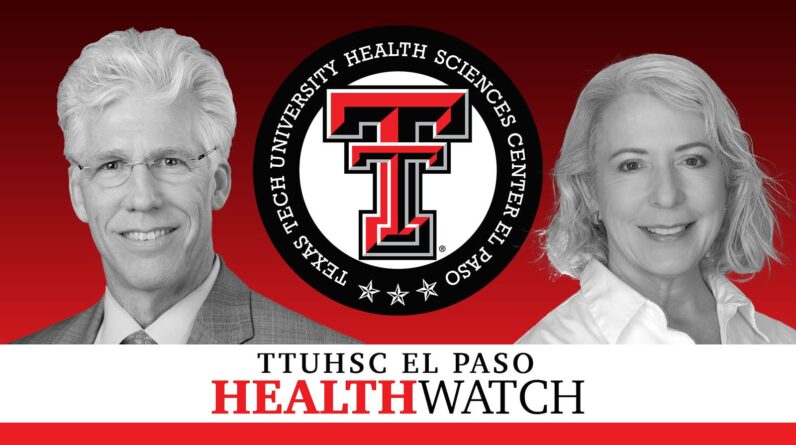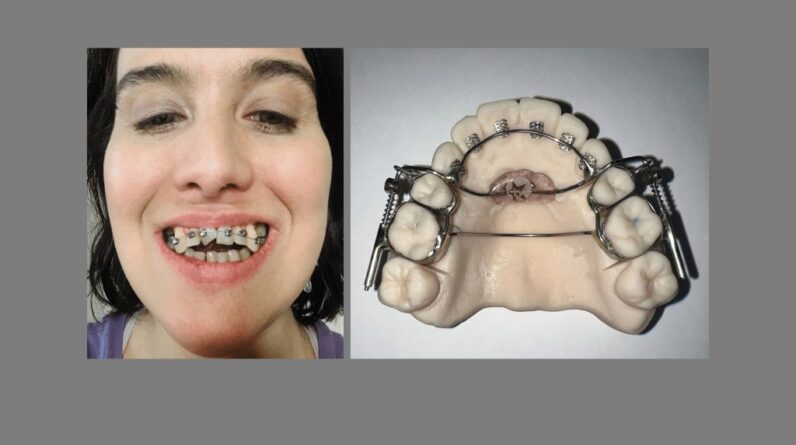
Health
TTHealthWatch is a weekly podcast from Texas Tech. In it, Elizabeth Tracey, director of electronic media for Johns Hopkins Medication in Baltimore, and Rick Lange, MD, president of the Texas Tech University Well being Sciences Centre in El Paso, seem at the top health-related tales of the week.
This week’s subjects include things like autism premiums amid males and ladies, penalties of atrial fibrillation, antipsychotics among the those people with dementia, and antibiotic use making use of artificial intelligence.
Method notes:
:forty one Atrial fibrillation and its difficulties
1:41 Elevated hazard variables
two:41 Deal with with medication or ablation
three:30 Autism heritability in males and ladies
four:thirty No aid for environmental shared factors
five:33 Attempted to account for with modeling
six:23 Antibiotics, synthetic intelligence, and widespread bacterial infections
seven:23 50 diverse variables
8:23 Individual-unique things
nine:10 Antipsychotics and dementia
ten:10 New antipsychotic use elevated danger of pneumonia
eleven:10 Care suppliers
twelve:forty two Conclude
Transcript:
Elizabeth: Can we explain the distinctive premiums of autism involving males and women?
Rick: The lifetime danger of atrial fibrillation and its issues.
Elizabeth: What are the adverse results associated with any psychotic use in persons with dementia?
Rick: And harnessing our digital overall health records to increase our antibiotic prescribing.
Elizabeth: Which is what we are conversing about this 7 days on TTHealthWatch, your weekly search at the clinical headlines from Texas Tech College Wellness Sciences Heart in El Paso. I am Elizabeth Tracey, a Baltimore-primarily based clinical journalist.
Rick: I am Rick Lange, president of Texas Tech College Health Sciences Center in El Paso, wherever I am also dean of the Paul L. Foster Faculty of Medication.
Elizabeth: Rick, if you are okay with it, I would like to begin with The BMJ and this issue of atrial fibrillation and its difficulties, which this analyze was form of a surprise to me.
Rick: I tee this up as the life span risk of atrial fibrillation, and they made use of the Danish nationwide population facts to glance at how popular is atrial fibrillation around a life time and precisely what issues are linked with it.
They looked at two various a long time, 2000 to 2010 and then 2011 to 2020, to look at people two distinct decades. Atrial fibrillation is an irregular coronary heart rhythm, the place the upper chamber of the heart variety of quivers. In the U.S. on your own in the up coming twenty to twenty five many years, there will be about 16 million folks that have it.
What’s the threat? They explained, okay, let us say you make it to age forty five and you haven’t had atrial fibrillation. What is the chance that you can expect to get it before you transform a hundred? At the time you have it, what are the connected problems? In the to start with ten years amongst 2000 and 2010, it was about 1 in 4 individuals in excess of the age of forty five produced atrial fibrillation. In the most the latest ten years, it really is now one in 3. That may be due to the fact we have experienced improved threat elements like superior blood pressure, being overweight, and diabetes, and it is far more popular in adult males as well.
Right here was a astonishing issue to me. All health care companies and most of our listeners will be conscious that it truly is linked with an elevated hazard of stroke. About twenty% of the people today experienced a stroke just after atrial fibrillation, even with the actuality they had been intended to be on blood thinners. But the incredible thing is they ended up two times as possible, there were 40% of people, that essentially developed heart failure. Then about 15% made a coronary heart attack.
Regrettably, even nevertheless we have gotten improved at diagnosing and hoping to address atrial fibrillation, the incidence of these was a reasonably slight lessen. Atrial fibrillation is on the rise and the issues materialize fairly often.
Elizabeth: I assumed it was just surprising, this fee of coronary heart failure, and I consider they had been a very little little bit surprised by that also.
Rick: Yeah, forty%. If you’ve got a 1-in-3 possibility of producing atrial fibrillation and 40% of individuals acquire heart failure, that states a thing. About a 3rd of people really do not have indications. When they do have atrial fibrillation, it is to address either with drugs or we now have ablation to hopefully assist decrease that chance. But more importantly is to stop it from developing.
The danger things for heart failure are the exact for atrial fibrillation. We can cut down the hazard of atrial fibrillation and its troubles if we command people points.
Elizabeth: Make it possible for me to also interject a query about physical exercise and its capability to prophylax against improvement of atrial fibrillation.
Rick: It is really a actually intriguing thing, Elizabeth. If you might be an elite athlete, it basically improves your threat of atrial fibrillation. But for people of us that do a modest quantity of exercising, a hundred and fifty minutes a week, it actually lowers all the other threat components and also cuts down the danger of atrial fibrillation as very well. If you’re significant about blocking coronary heart failure and you are severe about stopping atrial fibrillation, a great deal of that is in just our regulate.
Elizabeth: That’s the very good news. Let us transform, considering that we are more than in this location of the entire world, to Sweden. This is JAMA Psychiatrythe study that was inspecting intercourse dissimilarities in autism heritability. Autism spectrum dysfunction [ASD] is extremely typical and it feels like it truly is receiving identified much more and more generally. No person has at any time genuinely tried out to nail this down in this certain way just before.
The authors place forward the actuality that the induce of ASD is mostly genetic and they needed to search at the sexual intercourse-distinct heritability of this disorder. Employing the wellness registers of non-twin siblings and cousins from Sweden concerning 1985 and 1998, they followed them up to 19 several years of age. They had a sample of about a million people, with each and every family members owning about two small children 1.17% of that sample gained a prognosis of ASD — almost two times as several males as females.
They estimate the heritability amongst the males at 87%, and at seventy six% for females. It reported there was no assistance for shared environmental contributions. They posit a range of likely good reasons that may possibly be genuine, but they do not actually occur to a conclusion.
Rick: Element of that, Elizabeth, is that even even though two% to three% of American kids will be identified with an autism spectrum condition and we know there is some heritability, there are in all probability some environmental or other things that we just you should not comprehend.
Permit me just take a phase back again for a second, simply because some children with ASD have intellectual incapacity and some never. It appears that those with intellectual disability and autism that the heritability amongst males and women is the similar. But it really is individuals that have the considerably less extreme sort wherever it looks like the males have an amplified heritability than the women.
Now, it’s possible they are a lot more probably to build it. It could be some thing about the females that’s protecting. Some of it is the age at which they are identified — because females are normally diagnosed afterwards than males — and the displays are distinct. They tried out to account for all of this by performing different modeling. I would concur with you that there is an greater incidence amid males. Just why that is, is however unknown.
Elizabeth: They communicate about this woman protective result, which we have seen in other circumstances that female sex just appears to be to confer security. We even know this if we examine lifespans, for illustration. They experimented with to correct for so numerous of these things, though — the common suspects like parental age, the existence of the ailment already in the family members. Once again, I sense like they are indicating, “Yep, okay, there are a variety of opportunities, and the respond to is we you should not know.”
Rick: Yeah, I signify, for practically twenty many years we have been reporting, we incredibly seldom claimed on ASD to begin with and now it appears like we are reporting on two or a few things for every year. We are striving to get to the root lead to.
Elizabeth: In truth. All right, so let’s turn to JAMA. What are we likely to do about these antibiotics? How can we use them very best in frequent bacterial infections?
Rick: Yet another stunning point is that about 50 % the hospitalized adults in the U.S. acquire antibiotics. The two most frequent infections, by the way, are pneumonia and urinary tract infection [UTI]. Once more, around the final two many years, we have talked a great deal about antibiotic stewardship, earning guaranteed the individual has a bacterial infection, they’re on the ideal antibiotic for their particular organism, and we keep them on it for the nominal total of time. We’re carrying out this to attempt to protect against resistant microorganisms, what are termed multidrug-resistant organisms or MDROs.
The way we commonly do that is we admit any individual and we set them on a broad spectrum. We do that mainly because we do not know what the organism is and we are worried it could be a genuinely lethal a person. Get cultures to uncover out what microorganisms is infecting them and then three or four days afterwards we improve the antibiotics.
But what these investigators said is, hey, wait a minute. Much less than 10% of people today have a multidrug-resistant organism an infection. Can we focus on individuals persons for the wide spectrum and for the rest of them use anything that’s fewer selective?
To do that, they actually employed the digital health document [EHR] and they seemed at fifty distinctive variables. Some of them are relevant to the organism. Some of it related to the patient, their comorbidities, and in which they have been hospitalized. It predicted whether or not or not they were being likely to have an infection with a multidrug-resistant organism and necessary broad-spectrum antibiotics or they didn’t.
They diminished the broad-spectrum antibiotic use in people with pneumonia by about thirty%. For those people with urinary tract an infection, it lessened it by about 20%.
Did it damage the sufferers that ended up in the healthcare facility for a longer time? Do they have to go to the intense treatment unit? Did they have to swap antibiotics? The answer is none of individuals items. These ended up clients that ended up hospitalized with pneumonia or a UTI, but were not going to the intense treatment device, so it seems like the digital wellness document can increase our antibiotic stewardship. This is definitely a fantastic news story.
Elizabeth: It’s a wonderful information story, and I guess I’m interested in what some of people components are that predict what particular organism a person could possibly be contaminated with.
Rick: They search at what I get in touch with a area antibiogram. What are the most popular organisms causing pneumonia or urinary tract infection in that specific healthcare facility area and do they respond to antibiotics? Then there are client-unique things like demographics and comorbidities. Do they have a prior health care publicity, which would enhance our risk general?
Elizabeth: E ffectively, I’m actually intrigued in this idea that there are local flora, that there are selected organisms that are observed in sure regions and that are most typically likely to result in infections. What I would like to see would be a research over time, or seasonally, that appears at variations amid that populace and I’m sure we can get that facts.
Rick: Yep. In point, what you pointed out is a person of the limits of this review. 1st of all, it requires a big EHR, and some modest hospitals do not have that or community medical practitioners do not. The second is people have moved from location to region. If we are heading to definitely, broadly use this, we’re going to have to glance at how to overcome these points.
Elizabeth: Ultimately, let us turn back to The BMJ and this is a circumstance that we also have reported on beforehand: adverse outcomes involved with antipsychotic use in persons with dementia.
This is, nevertheless, a truly significant analyze from the Medical Observe Investigate Datalink, CPRD, in England. They had grown ups fifty yrs of age or more mature with a analysis of dementia among 1998 and 2018 — just shy of 200,000. Each new antipsychotic person, which was 35,000+, was matched with up to 15 non-customers utilizing this incidence density sampling.
What they wished to uncover out was if you are on an antipsychotic, did you encounter stroke, VTE [venous thromboembolism]an MI [myocardial infarction]coronary heart failure, ventricular arrhythmia, fracture, pneumonia or acute kidney personal injury. Then they had as adverse controls the results of appendicitis and cholecystitis.
Certain ample, if you had been on a new antipsychotic, you did have an amplified rate of principally pneumonia. That was the major greater danger. But all these other hazards were also amplified with that. They did not notice any elevated possibility in appendicitis or cholecystitis. It was really relating to and confirmatory of what we have described on previously.
Rick: Regrettably, the use of antipsychotics in persons with dementia was commencing to decline, and then for the duration of the COVID yrs it really elevated. We have recognised for, gosh, about 15 a long time that the antipsychotics are linked with the issues that you pointed out, and they actually have incredibly marginal profit at all.
We have to have to be genuinely restrictive in who we give these medications to — for all those that prescribe medications, to be conscious of this, but also for caregivers as very well. Due to the fact we imagine the simplest factor to do is if mother or dad has dementia and we can consider to control the antipsychotics, we can actually improve the chance of these significant difficulties and shorten their everyday living.
Elizabeth: I guess my coronary heart seriously goes out to treatment suppliers for people with dementia and the huge struggle it can be to deal with a lot of these behavioral challenges. The temptation to change to … and I should point out in this analyze that they note that risks are associated both with what are identified as atypical antipsychotics as very well as typical antipsychotic medication. It just would seem like, gosh, this is a resolve for one thing that can be really intractable.
Rick: It is. A single of the items that the investigators mentioned is that we really want to do additional investigation into what are some safer drug solutions. If there are behavioral or environmental alterations that we can make brief of applying drugs, that would be the basically chosen treatment.
Elizabeth: They note that the endeavor to use other points hasn’t been really fruitful possibly with what we have at the moment in the armamentarium. Let us just then conclusion with the authors’ notion. They state that when an antipsychotic prescription is the the very least lousy selection clinicians should test to do it for the shortest interval of time as possible.
Rick: Equally the smallest dose, it will get the desired impact, and for as brief as achievable. Great.
Elizabeth: On that note, which is a appear at this week’s medical headlines from Texas Tech. I am Elizabeth Tracey.
Rick: I’m Rick Lange. Y’all pay attention up and make healthy alternatives.





